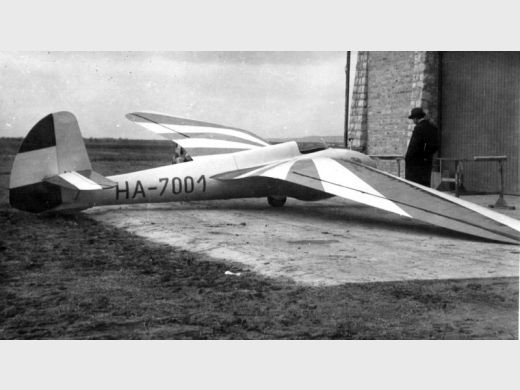
Rubik R-17 Moká
| DONNÉES GÉNÉRALES |
| Année du premier vol (ou de design, si seul projet) |
1944 |
| Pays | Hongrie |
| Designer(s) | RUBIK, Ernõ |
| Premier constructeur | Aero Ever Ltd., Esztergom |
| Type d'appareil | Planeur |
| Fonction | Voltige |
| SPÉCIFICATIONS TECHNIQUES |
| Envergure | 13 m |
| Longueur | 6.5 m |
| Hauteur | -- |
| Allongement | 10.56 |
| Surface alaire | 16 m2 |
| Profil aile | NACA 23012 |
| Masse à vide | 280 kg |
| Masse maxi | 370 kg |
| Charge alaire | 23 kg/m2 |
| Vitesse mini | -- |
| Vitesse maxi | -- |
| Finesse maxi | 22.4 |
| Taux de chute mini | 0.88 m/s à 74 km/h |
| Nb sièges | 1 |
| Structure | R-17: tout bois; R-17b: bois avec ailerons en métal léger. |
AUTRES INFORMATIONS
| Constructeur(s) |
| ||||||
| Infos techniques | Ailes en mouette. Patin et roue fixe | ||||||
| Histoire résumée | Monoplace d'acrobatie. Solide construction en bois. Ernõ Rubik, part-owner of the Aero-Ever Ltd. and designer of the gliders built there, in 1937 started to design the first Hungarian aerobatic glider following the example presented by the Habicht. The glider's general arrangement reflected the requirements of aerobatics. The designer's aim was to create an agile glider with adequate strength. The new glider resembled Habicht, however the Móka had different dimensions as well as different airfoil. Another difference was the wing structure. The Móka's wing was built as a single structural unit and its fuselage did not take loads from the wing. The prototype first flew at the spring of 1944. According to the glider's stress analysis the maximum diving speed was 520 km/h, however to prevent flutter the Vne was restricted to 400 km/h. The only problem the test flights revealed was the excessive aileron control forces at high speeds. During the besiege of Budapest in 1945, the glider was destroyed. After the war the design bureau headed by Ernõ Rubik got a task from the newly organized Hungarian National Flying Association (OMRE) to reconstruct the drawings of the destroyed R-17 glider and modify them according to the findings of the test flights. This work was done between 1948 and 1950. The aim of redesigning the R-17 was to reduce the mass as well as to improve the handling capabilities of the glider. The new version got the designation of R-17b and had the same main dimensions as the R-17, however got a new fuselage (of the R-22S). The production of three gliders had been started at the Sportárutermelõ Vállalat (Sports Gear Factory), the legal successor of Aero Ever Ltd. The first glider first flew in the fall of 1950. During slow-speed test flights the glider performed well, however aileron flutter were experienced during high-speed tests, which had not been present with the previous version. During one of the test flights the control stick was snatched from the pilot's grip and the flight ended with crash. The test flights continued with the second glider, however one of them ended in catastrophe. When pulling up from a high-speed dive of 400 km/h, the wings had broken up because of the intensive aileron flutter and the pilot was killed. The test flights were ended and the whole project was dropped, though eliminating the flutter would have been a possible course of action. For glider aerobatics L-107 Lunak gliders were ordered by OMRE. Both versions were authorized for cloud flying. Within the permissible speed limits all kinds of aerobatic manoeuvres were allowed to fly. | ||||||
| Liens personnalités | RUBIK, Ernõ (Hongrie) |
SOURCES DOCUMENTAIRES
| Liens WEB | Site : Hungarian Gliders (site de Gábor Fekecs) . Note + 4 photos + plan 3 vues + specs. (2010-06-03 CL) Site : UIUC Applied Aerodynamics Group . NACA 23012 airfoil. (2010-05-19 JM) Site : UIUC Applied Aerodynamics Group . NACA 23012 fichier DAT. (2010-05-19 JM) |
| Livres | The world's sailplanes par OSTIV (1958) [p. 138 - 141. 3-vues + specs + description]. |

Team J2mcL © 2003 -
- Pages optimisées pour Mozilla Firefox

